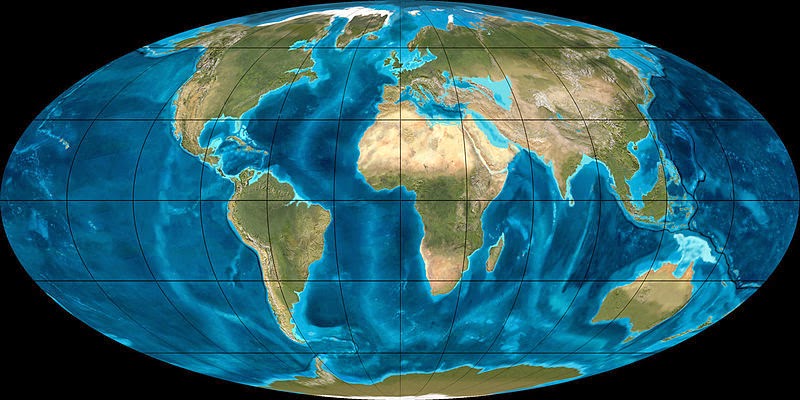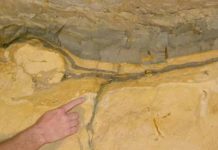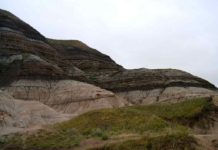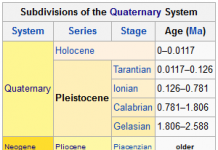
The Neogene is a geologic period and system in the International Commission on Stratigraphy (ICS) Geologic Timescale starting 23.03 ± 0.05 million years ago and ending 2.588 million years ago. The second period in the Cenozoic Era, it follows the Paleogene Period and is succeeded by the Quaternary Period. The Neogene is subdivided into two epochs, the earlier Miocene and the later Pliocene.
The Neogene covers about 20 million years. During this period, mammals and birds continued to evolve into roughly modern forms, while other groups of life remained relatively unchanged. Early hominids, the ancestors of humans, appeared in Africa. Some continental movement took place, the most significant event being the connection of North and South America at the Isthmus of Panama, late in the Pliocene. This cut off the warm ocean currents from the Pacific to the Atlantic ocean, leaving only the Gulf Stream to transfer heat to the Arctic Ocean. The global climate cooled considerably over the course of the Neogene, culminating in a series of continental glaciations in the Quaternary Period that follows.
Divisions
In ICS terminology, from upper (later, more recent) to lower (earlier):The Pliocene Epoch is subdivided into 2 ages:
- Piacenzian Age, preceded by
- Zanclean Age
- Messinian Age, preceded by
- Tortonian Age
- Serravallian Age
- Langhian Age
- Burdigalian Age
- Aquitanian Age
In different geophysical regions of the world, other regional names are also used for the same or overlapping ages and other timeline subdivisions.The terms Neogene System (formal) and upper Tertiary System (informal) describe the rocks deposited during the Neogene Period
Climate and geography
The continents in the Neogene were very close to their current positions. The isthmus of Panama formed, connecting North and South America. India continued to collide with Asia, forming the Himalayas. Sea levels fell, exposing land bridges between Africa and Eurasia and between Eurasia and North America.
The global climate became seasonal and continued its overall drying and cooling trend which began in the beginning of the Paleogene. The ice caps on both poles began to grow and thicken, and by the end of the period the first of a series of glaciations of the current Ice Age began.
Flora and fauna
Marine and continental flora and fauna were fairly modern at this time. Mammals and birds continued to be the dominant terrestrial vertebrates, and took many forms as they adapted to various habitats. The first hominids, the ancestors of humans, appeared in Africa and spread into Eurasia.
In response to the cooler, seasonal climate, tropical plant species gave way to deciduous ones and grasslands replaced many forests. Grasses therefore greatly diversified, and herbivorous mammals evolved alongside it, creating the many grazing animals of today such as horses, antelope, and bison.
Disagreements
The Neogene traditionally ended at the end of the Pliocene Epoch, just before the older definition of the beginning of the Quaternary Period; many time scales show this division.
However, there was a movement amongst geologists (particularly Neogene Marine Geologists) to also include ongoing geological time (Quaternary) in the Neogene, while others (particularly Quaternary Terrestrial Geologists) insist the Quaternary to be a separate period of distinctly different record. The somewhat confusing terminology and disagreement amongst geologists on where to draw what hierarchical boundaries, is due to the comparatively fine divisibility of time units as time approaches the present, and due to geological preservation that causes the youngest sedimentary geological record to be preserved over a much larger area and to reflect many more environments, than the older geological record. By dividing the Cenozoic Era into three (arguably two) periods (Paleogene, Neogene, Quaternary) instead of 7 epochs, the periods are more closely comparable to the duration of periods in the Mesozoic and Paleozoic eras.
The ICS once proposed that the Quaternary be considered a sub-era (sub-erathem) of the Neogene, with a beginning date of 2.588 Ma, namely the start of the Gelasian Stage. In the 2004 proposal of the International Commission on Stratigraphy (ICS), the Neogene would have consisted of the Miocene and Pliocene epochs. The International Union for Quaternary Research (INQUA) counterproposed that the Neogene and the Pliocene end at 2.588 Ma, that the Gelasian be transferred to the Pleistocene, and the Quaternary be recognized as the third period in the Cenozoic, citing key changes in Earth’s climate, oceans, and biota that occurred 2.588 Ma and its correspondence to the Gauss-Matuyama magnetostratigraphic boundary. In 2006 ICS and INQUA reached a compromise that made Quaternary a subera, subdividing Cenozoic into the old classical Tertiary and Quaternary, a compromise that was rejected by International Union of Geological Sciences because it split both Neogene and Pliocene in two.
Following formal discussions at the International Geological Congress, Oslo Norway, August 2008, the International Commission on Stratigraphy (ICS) decided in May 2009 to make the Quaternary the youngest period of the Cenozoic Era with its base at 2.588 Mya and including the Gelasian age, which was formerly considered part of the Neogene Period and Pliocene Epoch. Thus the Neogene Period ends bounding the succeeding Quaternary Period at 2.588 Mya.
Note : The above story is based on materials provided by Wikipedia










